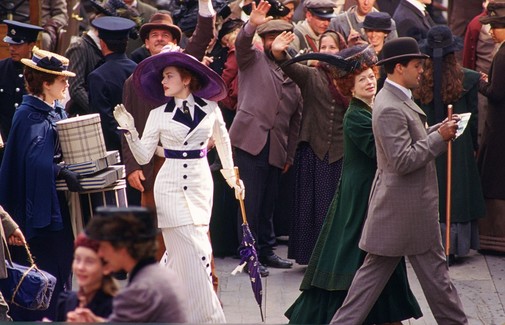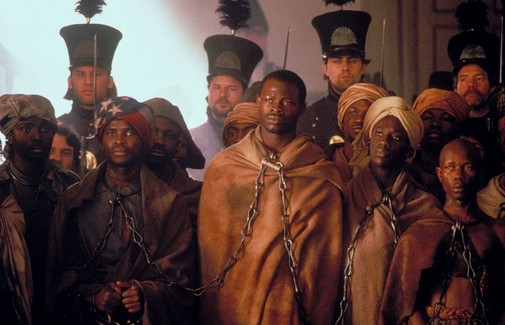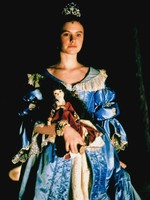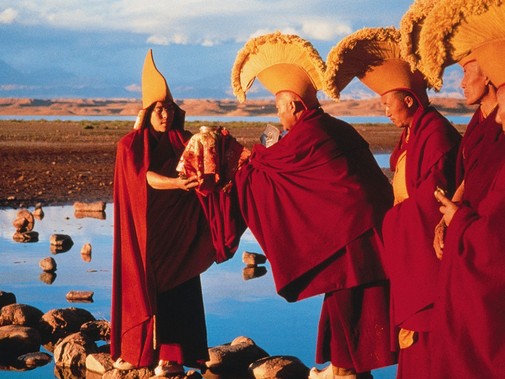Before we say goodbye to 1997 and move on to 1951, let's indulge in what has become a Smackdown tradition. After Nathaniel and his panelist do their Supporting Actress analysis and podcast discussion, it's time for some costume-related musings. Like most of the categories in that year's Oscars, the Best Costume Design race was won by Titanic, which shouldn't be surprising. Not only was the movie a sweeper, but its wardrobe has achieved iconic status in the decades since its original release. Deborah Lynn Scott makes for a just victor, not only because of her work's iconographic power but also because it works within the picture's purview of history and romance…
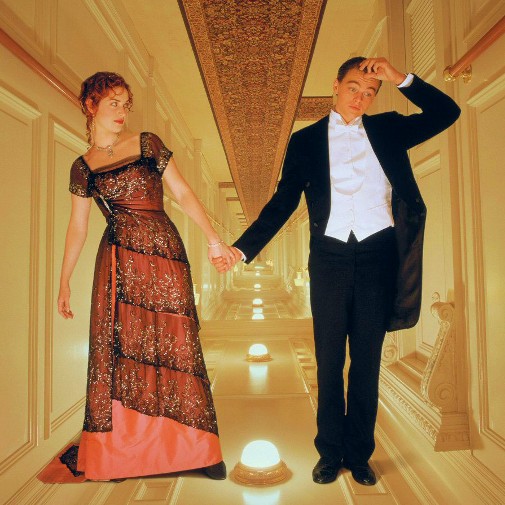
Despite the narrative shades of fairytale fantasy, James Cameron pursued an idea of uttermost authenticity when evoking the doomed ship that sank on its maiden voyage. The sets are replicas of the original spaces, and while the costumes aren't as bound to direct recreation, they're still the fruit of thorough research. Scott examined extant gowns as part of her process, further studying the latest trends of 1912 and how the cast's social hierarchies could manifest in their clothing. One of Titanic's most impressive qualities is just how far the eye can stray from the main action without losing any production quality.
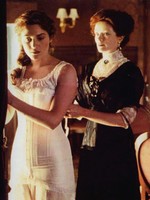 In other words, even the most faraway extra is dressed to the nines, just as beautifully costumed as the movie's stars. That's not to say Kate Winslet isn't mad to stand out from the crowd around her. For one, her outfits are the ones that owe the least to history, bending to contemporary sensibilities in their silhouette and foundational garments. The famous corset-lacing scene is rather absurd from a historical perspective. At the time, an hourglass figure wasn't preferred, and the undergarments were so relatively unstructured that it would have been near impossible to tight-lace.
In other words, even the most faraway extra is dressed to the nines, just as beautifully costumed as the movie's stars. That's not to say Kate Winslet isn't mad to stand out from the crowd around her. For one, her outfits are the ones that owe the least to history, bending to contemporary sensibilities in their silhouette and foundational garments. The famous corset-lacing scene is rather absurd from a historical perspective. At the time, an hourglass figure wasn't preferred, and the undergarments were so relatively unstructured that it would have been near impossible to tight-lace.
However, Titanic is, at its heart, a romantic melodrama. That means such flights of fancy can coexist with the rigorous material realism seen elsewhere without seeming out of place. But of course, as a fashion history geek, I'm more infatuated with how Scott uses period idiosyncrasies to aid in the storytelling without capitulating to 90s paradigms. Notice the boned collars of Frances Fisher's frocks, her rigid identity illustrated in fashionable trappings. There's also the visceral beauty of Winslet's sinking dress, whose diaphanous lightness both signals her physical fragility in the face of catastrophe and the ghostly sweetness of memory.
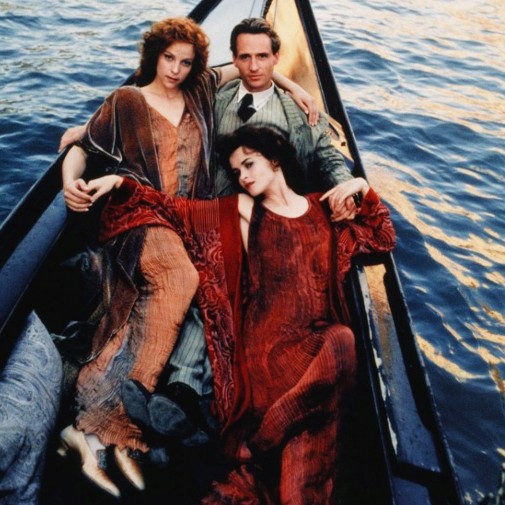
For a more exact portrayal of the 1910s, one has The Wings of the Dove and its Sandy Powell-designed costumes. In this Henry James adaptation, clothes act as social barometers and visualizers of transitional changes in fashion, psychology, and overall culture. That's, at least, what they do in an intellectual capacity. More instinctually speaking, there's a great preoccupation with sensuality, evoking touch through contrasting textures and showy textile treatments. The art of Klimt and the period's Orientalist tastes make for essential references, providing a baseline for Powell's usual games of clashing patterns and intense color stories.
Helena Bonham Carter's Kate is the designer's best model, living in a limbo of financial patronage from her wealthy Poiret-clad aunt and, later on, the American heiress' friendly support. Her few Fortuni-pleated gowns are among the year's most ravishing costumes, appearing startlingly modern while keeping faithful to historical trends. Another perfect detail is the predominance of veils in the character's wardrobe. A master of deception, Kate often gazes at others through a screen of silk netting or light gauze. Powell thus gives tangible shape to her leading lady's complex interiority – a feat of costume design as dramaturgical aid.
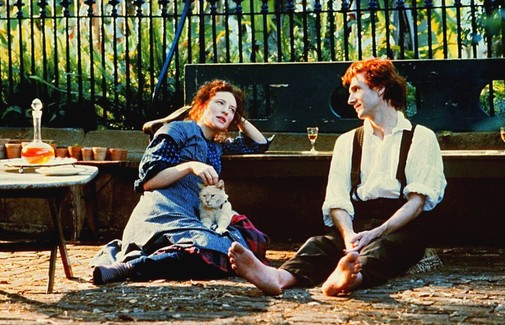
Sandy Powell is one of those designers whose specific vision is consistent enough to make her something of an auteur in her own right. The same could be said of Janet Patterson, nominated this year for her work in Gillian Armstrong's Oscar and Lucinda. The 19th-century-set film tells the story of two neurotics whose obsessions set them on a Fitzcarraldo-like path toward tragic conclusions. It's a tonal gambit of immense risk, eccentric to a maddening degree but curiously allergic to the romanticizing of its protagonists. Consequently, the costumes have to walk a fine line between a disaffected view of the past and the acknowledgment of the character's strangeness.
Faced with these challenges, Patterson delivers a masterpiece of period specificity crossed with textual oddness. Her creations are beautiful but always presented with an off-kilter twist, be it the combination of prints, the over-abundance of visual noise, subverted gender norms and dress reform trends, or peculiar palettes. If you're like me, mid-Victorian fashion isn't synonymous with excitement, making Patterson's accomplishments all the more impressive. Years later, she did a similar trick when reimagining the precepts of Regency wear for Jane Campion's Bright Star. If only all period costume designers were as creative as Patterson.
Still, romanticism and eccentricity aren't the be-all and end-all of historical fashion in film.
Sometimes, a sober-minded recreation is the best approach, as seen in Spielberg's Amistad with costumes by Ruth E. Carter. Throughout her career, the designer has dedicated significant effort to the screen representation of Black history, showing it off with great attention to detail and historical realism. Part of that comes from her background and experience, having worked in Colonial Williamsburg alongside historians before entering the world of film.
Carter has said Spielberg was very collaborative in his approach, giving her autonomy to do deep research into such documents as flea market etchings, archives from Italian opera houses, and more. Bindman and Gates Jr.'s The Image of the Black in Western Art was another critical reference point. While not especially showy, the final costumes offer a wealth of information, often digging deeper into this real-life episode than the script. Great details involve an African prisoner wearing the American flag as a turban and the efforts of abolitionists to project an image of respectability toward the white lawmakers.
Finally, Martin Scorsese's Kundun occupies the last slot in the 1997 Best Costume Design lineup. The controversial production is simultaneously one of the director's most contentious projects and one of his most forgotten. That last part is unfortunate, considering the scope and ambition present on screen, going beyond the logistical grandeur to the realm of complicated politics, clashing historical perspectives, and cultural specificities. To bring the world of the Dalai Lama to cinemas, Scorsese returned to long-time collaborator Dante Ferretti who took on set and costume design duties, both of which earned him Oscar nominations.
This was only the second of three times when the Italian filmmaker did a production's wardrobe – the others are Luigi Comencini's 1974 period drama Till Marriage Do Us Part and Scorsese's 2016 Silence. However, his lack of experience doesn't correlate with a lack of talent. Fidelity to the documented fact is the foremost priority while providing elements of visual splendor that fit into the general opulence of Roger Deakins' lensing. Regard seas of red cloth signifying religious order and bloody massacre, how gold invokes imperial tradition detached from aristocratic rule, and how a person is turned into an icon of humanity transcended.
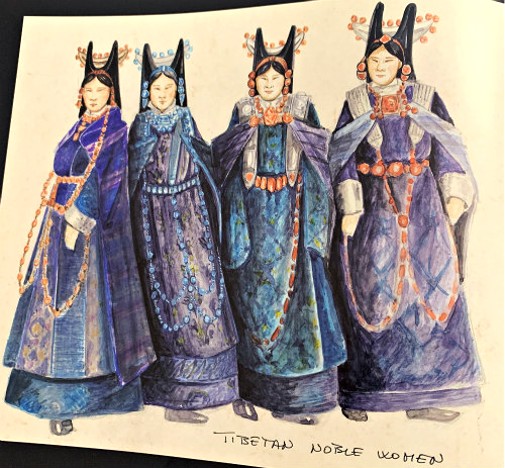
Those were AMPAS' selected five, but 1997 had plenty of other excellent examples of Oscar-eligible costume design. Here's a personal top 10 of unnominated achievements, plus some honorary mentions:
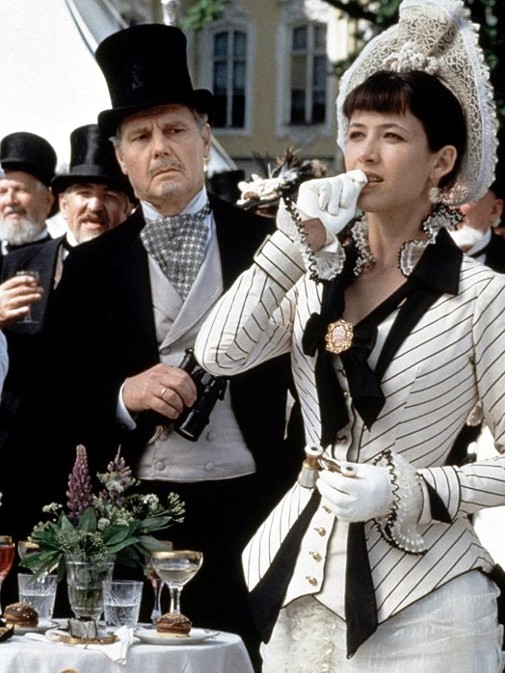
ANNA KARENINA
Costumes designed by Maurizio Millenotti
If you love bustle gowns, especially natural form ones, then Bernard Rose's Anna Karenina is essential viewing. Millenotti delivers astounding historical detail presented in somber colors. Indeed, it's impressive how much the costumes evoke the rotting decadence of the Russian aristocracy while working within a milieu of chromatic severity, mourning blacks, and virginal whites.
You can find Anna Karenina on Apple iTunes.

B*A*P*S
Costumes designed by Ruth E. Carter
Sure, Carter's period creations for Amistad are wonderful, but I'd argue her contemporary stylings for this comedy are even more outstanding. Costume design as a comedy instrument always fascinates me, and B*A*P*S is a prime example of the art form. Halle Berry's plasticky outfits are especially fun, designed to be slippery for a very wet comedic set piece.
B*A*P*S can be found on most services, available to rent or purchase.

BOOGIE NIGHTS
Costumes designed by Mark Bridges
If I were in charge of giving out Oscars, Mark Bridges would have won his first statuette for PTA's first masterpiece. Boogie Nights details the height of porno chic in the 1970s and the transition into the seedy underbelly of 80s video pornography. There's a plethora of eye candy to consider, from movie-in-movie costume design to the skewed aesthetics of those who spend their fortune to look like an idealized vision of success. The clothing is an essential part of the immersive filmmaking, drowning you in the palpable reality of the recent past, exorcised and exploded on the silver screen.
Boogie Nights is streaming on Netflix and Rakuten Viki.
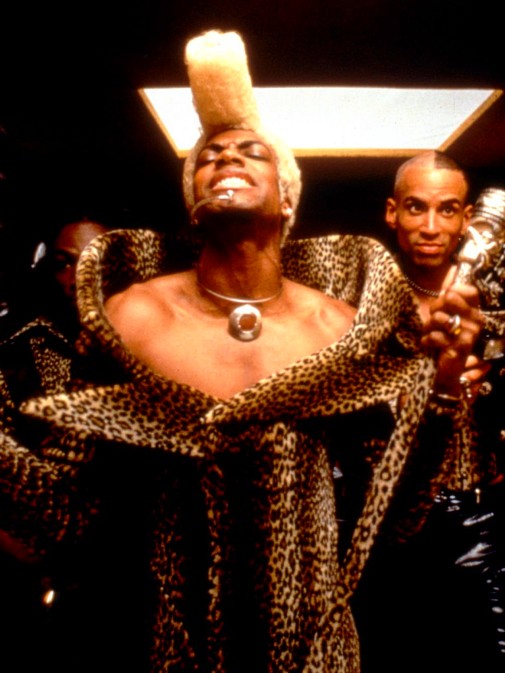
THE FIFTH ELEMENT
Costumes designed by Jean-Paul Gaultier
When the worlds of fashion and film intersect, you may get some of the most fantastic stylistic madness the mind can conceive. Such is the case of Luc Besson's The Fifth Element, a sci-fi circus inspired by the work of comic book artists like Moebius and Jean-Claude Mézières. To dress his cast of quirky humans and grotesque aliens, the director got Gaultier, who appealed to precepts of utter excess, the imagination unbound by conventionalities like elegance or good taste.
The Fifth Element is available for rent or purchase on most big platforms.
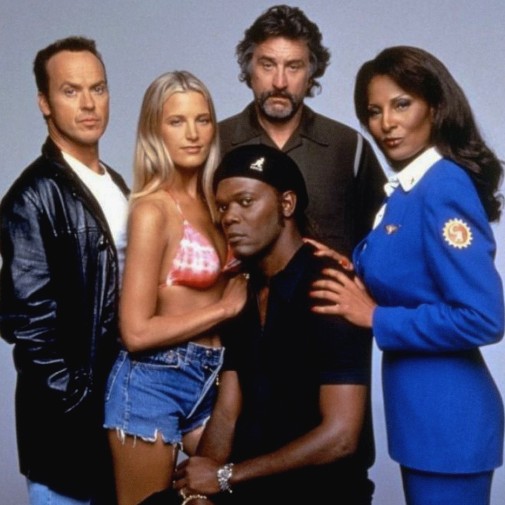
JACKIE BROWN
Costumes designed by Mary Claire Hannan
Though only one of his movies has been nominated for the Best Costume Design Academy Award, Quentin Tarantino's filmography is consistently excellent when it comes to sartorial matters. Jackie Brown isn't opulent like some of his other flicks, but there's plenty of style to go around. Moreover, Hannan takes advantage of the late 90s' 70s revival to draw an umbilical cord between this story's characters and the history of neo-noir and Blaxploitation.
Jackie Brown is streaming on HBO, HBO Max, DirecTV, and Max Go.
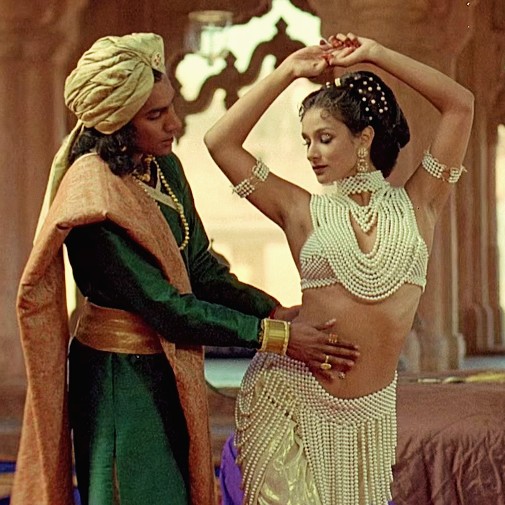
KAMA SUTRA: A TALE OF LOVE
Costumes designed by Eduardo Castro
Sensuality reigns supreme in Mira Nair's Kama Sutra, a melodrama loosely inspired by the eponymous writings and Wajida Tabassum's story Hand Me Downs. Clothing as a status symbol is ever-present throughout the narrative, but Castro's designs must also juggle impressions of 16th-century Punjab culture with a taste for fairy tale dazzlement. Whether in peacock colors or cascades of pearls, the cast looks consistently gorgeous, like stars of Old Bollywood musicals turned into erotic illustrations.
Kama Sutra: A Tale of Love can be rented on some of the major services, including Apple iTunes and Amazon.
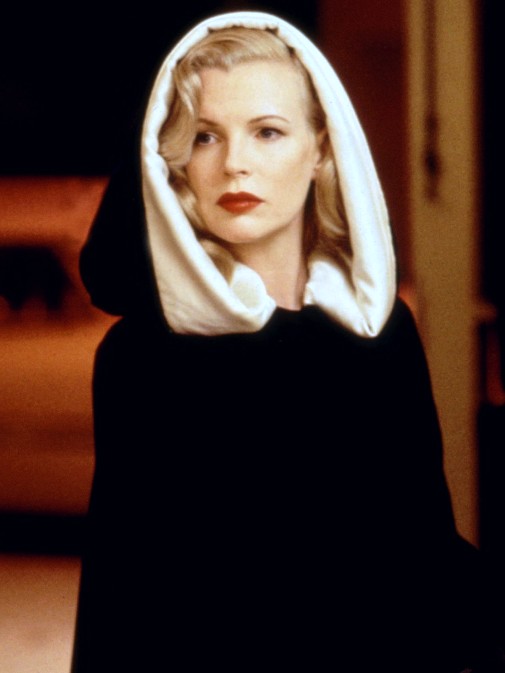
L.A. CONFIDENTIAL
Costumes designed by Ruth Myers
If the Almost There series expanded beyond the acting categories, L.A. Confidential could be a good example to write about. With its BAFTA nomination, it's apparent that Myers' work had industry support which is only logical. After all, her precise 1950s designs delineate subtle variations of midcentury masculinity and offer considerations of Hollywood history superimposed over personhood. The black cloak lined with a froth of cream silk worn by Kim Basinger might be the best individual costume of the entire year.
L.A. Confidential is streaming on Starz. You can also rent it on Apple iTunes and DirecTV.
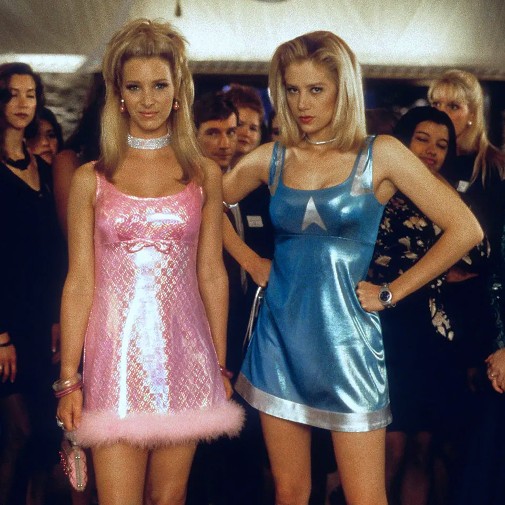
ROMY AND MICHELE'S HIGH SCHOOL REUNION
Costumes designed by Mona May
After Clueless, Mona May delivered another masterpiece of 90s comedy costuming with Romy and Michele's High School Reunion. The designer created two unforgettable figures by dressing the iconoclastic lead characters in their offbeat fashions. Moreover, every character is perfectly costumed, from the dreamed slew of bitches in pastels to the final punchline of a goth in floral print.
Romy and Michele's High School Reunion is streaming on Amazon Prime Video, Paramount+, Epix, and DirecTV.
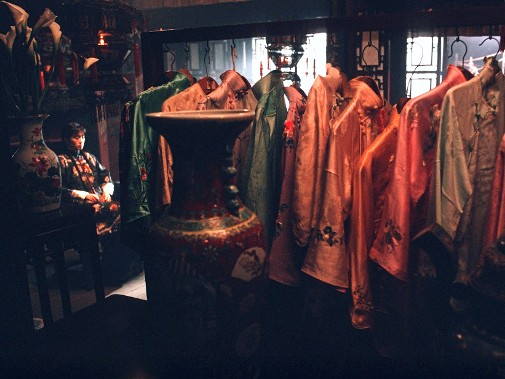
TEMPTRESS MOON
Costumes designed by William Chang
Chen Kaige's follow-up to Farewell, My Concubine is an intoxicating nightmare of early-20th-century Shanghai as seen through clouds of opium smoke. Tensions between modernity and tradition, Western influence and Chinese identity are constant, manifesting in various sartorial hauntings. Leslie Cheung's pale suits are especially memorable, as are Gong Li's embodiments of fashionable temptation.
Unfortunately, Temptress Moon isn't streaming anywhere in the US. However, the film is available on DVD.
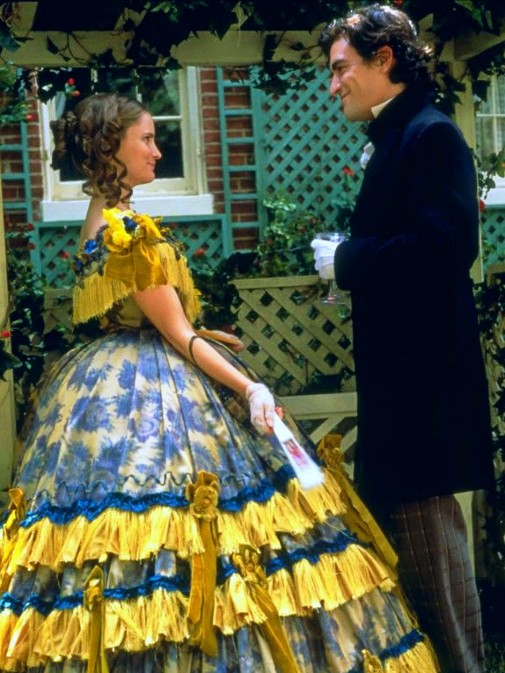
WASHINGTON SQUARE
Costumes designed by Anna B. Sheppard
Oscar obsessives will be familiar with the narrative of Agnieszka Holland's Washington Square since it's adapted from the same Henry James novel that brought us The Heiress. While the 1997 film isn't as flawless as the de Havilland classic, there's much to recommend. The costumes, in particular, dive deep into the uglier side of 1850s styles, invoking a portrait of dysfunctional personalities that complements the text.
Washington Square is available to rent on most of the big services.
Speaking of intentional ugliness, Cindy Sherman's Office Killer is another example of exemplary costuming from the 1997 film year. Female Perversions also plays on executive themes of executive realness, weaponizing 90s minimalist chic to find the fetishistic possibilities of ordinary office wear. The Selena biopic starring Jennifer Lopez explores another side of contemporary style, replicating the famous singer's iconic style. Midnight in the Garden of Good and Evil is one of Eastwood's oddest films, queer and indulgent, seeping into its milieu of Southern Gothic with gleeful style. If you love glamour, you have to check Lady Chablis' wardrobe for that strange picture. Finally, while I could write about 1997 costume design for the length of an entire book, let's end these musings with a shout-out to Batman & Robin. That camp fest features a cornucopia of sartorial absurdities, nipple-forward armor, and ecological terrorist fantasy. It's so fun!
What would your 1997 Best Costume Design ballot look like?
